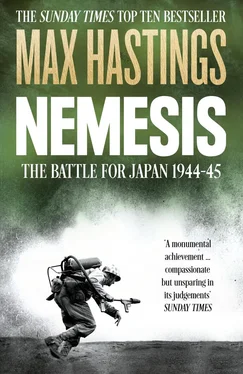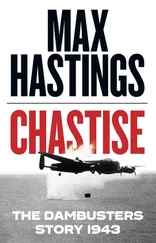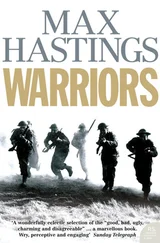In Britain and the US I have interviewed some veterans, but focused my research chiefly upon the huge manuscript and documentary collections which are available. My splendid Russian researcher, Dr Luba Vinogradovna, conducted interviews with Red Army veterans, and also translated a mass of documents and written narratives. In China and Japan I have sought out eyewitnesses. Most published Chinese and Japanese memoirs reveal more about what people claim to have done than about what they thought. I will not suggest that face-to-face interviews with a Westerner necessarily persuaded Chinese and Japanese witnesses to open their hearts, but I hope that the tales which emerge make some characters seem flesh and blood, rather than mere strangled Asian names speaking tortured English.
In most Western accounts of the war, the Japanese remain stubbornly opaque. It is striking how seldom Japanese historians are quoted in US and British scholarly discussions. This is not, I think, a reflection of American or British nationalistic conceit, but rather of the lack of intellectual rigour which characterises even most modern Japanese accounts. There is a small contributory point, that literal translations from the Japanese language cause statements and dialogue to sound stilted. Where possible here, I have taken the liberty of adjusting quoted Japanese speech and writing into English vernacular. Scholars might suggest that this gives a misleading idea of the Japanese use of language. It may help, however, to make Asian characters more accessible. With the same intention, although the Japanese place surnames before given names, I have reversed this in accordance with Western practice.
I have adopted some other styles for convenience. The Japanese called their Manchurian puppet state ‘Manchukuo’. Modern Chinese never speak of ‘Manchuria’, but of ‘the north-eastern provinces’. Nonetheless, I have here retained the name ‘Manchuria’, save when the Japanese political creation is discussed. Modern Indonesia is referred to as the Dutch East Indies, Malaysia as Malaya, Taiwan as Formosa and so on. After much vacillation, however, I have adopted modern pinyin spellings for Chinese names and places, because these are more familiar to a modern readership. I have, however, accepted the loss of consistency involved in retaining the familiar usages ‘Kuomintang’ and ‘Manchukuo’. Naval and military operations are timed by the twenty-four-hour clock, while the twelve-hour clock is used in describing the doings of civilians.
China is the country which today provides a historical researcher with the greatest revelations. I first visited it in 1971 as a TV film-maker, and again in 1985 when writing a book on the Korean War. On neither assignment was it possible to break through the ironclad culture of propaganda. In 2005, by contrast, I found ordinary Chinese welcoming, relaxed, and remarkably open in conversation. Many, for instance, do not hesitate to assert a respect for Chiang Kai-Shek, and reservations about Mao Zedong, which were unavowable thirty years ago.
Some Chinese bitterly observed to me that they found the Maoist Cultural Revolution a worse personal experience than the Second World War. Almost all those with Nationalist associations suffered the confiscation and destruction of their personal papers and photographs. Several served long terms of imprisonment—one because wartime service as a Soviet-sponsored guerrilla caused him to be denounced twenty years later as a Russian agent. I conducted almost all my own interviews in China and Japan, with the help of interpreters, but four former Chinese ‘comfort women’ of the Japanese army declined to tell their stories to a man and a Westerner, and instead talked to my splendid researcher, Gu Renquan.
In modern China, as in Russia and to some degree Japan, there is no tradition of objective historical research. Absurd claims are thus made even by academics, unsupported by evidence. This is especially true about the China-Japan war, which remains a focus of national passions, fomented by the Chinese government for political purposes. An appropriately sceptical Western researcher, however, can still achieve much more than was possible a decade or two ago. I found it exhilarating to stand on the snowclad border with Russia, where Soviet armies swept across the Ussuri river in August 1945; to clamber through the tunnels of the massive old Japanese fortress at Hutou, some of which have today been reopened as part of the local ‘Fortress Relics Museum of Japanese Aggression against China’; to meet peasants who witnessed the battles. In a café in Hutou, at nine in the morning local people were clustered around the big TV, watching one of the melodramas about the Japanese war which Chinese film-makers produce in industrial quantities. These celluloid epics, echoing with the diabolical laughter of Japanese occupiers as they slaughter heroic Chinese peasants, make such Hollywood war movies as The Sands of Iwo Jima seem models of understatement.
When I asked Jiang Fushun, in 1945 a teenage peasant in Hutou, if there were any happy moments in his childhood, he responded bitterly: ‘How can you ask such a question? Our lives were unspeakable. There was only work, work, work, knowing that if we crossed the Japanese in any way, we would go the way of others who were thrown into the river with their hands tied to a rock.’ In his flat in Harbin, eighty-four-year-old Li Fenggui vividly re-enacted for me the motions of a bayonet fight in which he engaged with a Japanese soldier in 1944.
Likewise, in Japan, at the tiny doll’s house in a Tokyo suburb where he lives, Lt Cmdr Haruki Iki cherishes a plastic model of the torpedo bomber which he once flew, alongside a garish painting of the British battlecruiser Repulse, which he sank in 1941. To meet him is to encounter a legend. At eighty-seven, former navy pilot Kunio Iwashita retains the energy and quick movements of a man thirty years younger. Today he is known in Japan as ‘Mr Zero’. I met him when he had just returned from the premiere of a lurid new Japanese movie epic, Men of the Yamato. Iwashita overflew the vast battleship on the morning she was sunk in April 1945, and has never forgotten the spectacle. He said with a wry smile: ‘I sobbed all the way through the film.’
I asked another navy fighter pilot, Toshio Hijikata, how he and his comrades spent their hours on Kyushu in the early months of 1945, as they prepared to scramble to meet American B-29 formations in the same fashion as RAF pilots waited for the Luftwaffe five years earlier, during the Battle of Britain. ‘We played a lot of bridge,’ said Hijikata. ‘It was part of the whole ethos of the Imperial Japanese Navy, which tried so hard to emulate the Royal Navy.’ The notion of Japanese fliers calling ‘three spades, four clubs’ to each other between sorties seemed irresistibly unexpected and droll.
My daughter once observed in a domestic context: ‘Life is what you are used to, Daddy.’ This seems an important truth in understanding human responses to circumstances. To a remarkable degree the young, especially, adapt to predicaments which might seem unendurable, if these are all that they have known. Across the globe, the generation which grew to maturity during the Second World War learned to accept war’s terrors and privations as a norm. This applies to many people whose stories I seek to record in this book.
Some general observations can be made about evidence, of which the most obvious is that scepticism is in order, even when reading formal contemporary minutes of meetings, unit war diaries or ships’ logs. Few official narratives in any language explicitly acknowledge disaster, panic or failure, or admit that people ran away. Likewise, many splendid lines attributed by historians to participants are probably apocryphal. People find it infinitely easier to imagine afterwards what should have been said in crises, rather than what actually was. Witticisms which survive through the generations retain a certain validity, however, if they seem to catch a spirit of the moment, like ‘Nuts!’, the alleged American response to a German demand for surrender at Bastogne.
Читать дальше












